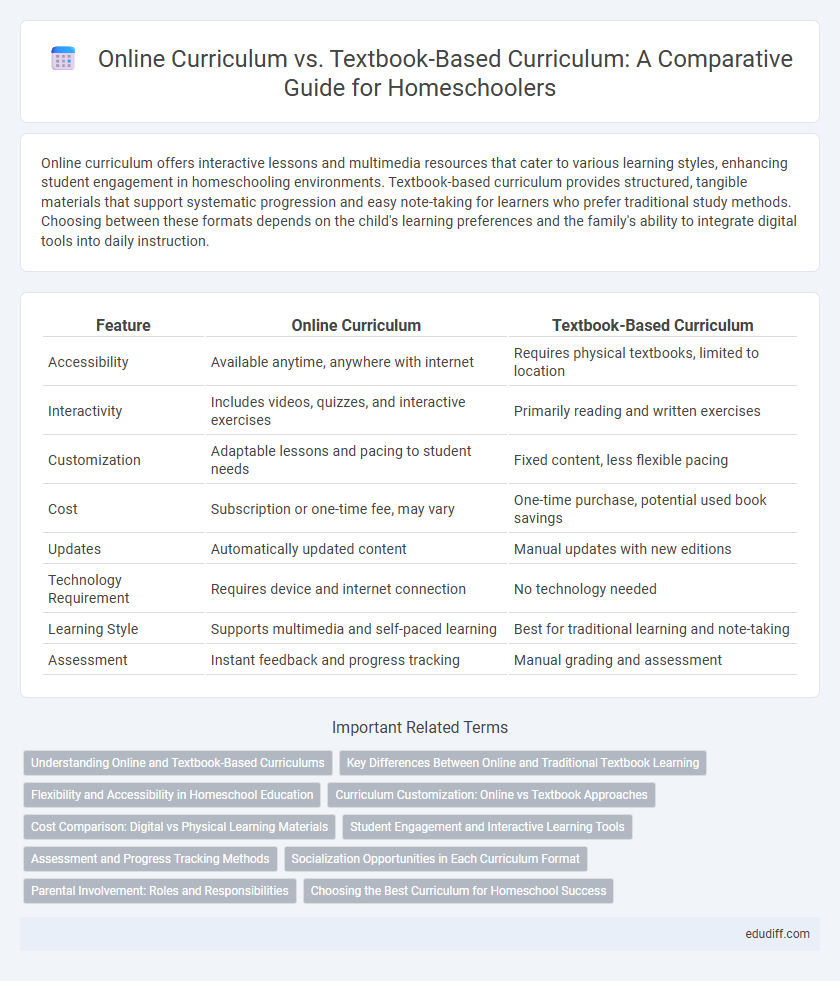Online curriculum offers interactive lessons and multimedia resources that cater to various learning styles, enhancing student engagement in homeschooling environments. Textbook-based curriculum provides structured, tangible materials that support systematic progression and easy note-taking for learners who prefer traditional study methods. Choosing between these formats depends on the child's learning preferences and the family's ability to integrate digital tools into daily instruction.
Table of Comparison
| Feature | Online Curriculum | Textbook-Based Curriculum |
|---|---|---|
| Accessibility | Available anytime, anywhere with internet | Requires physical textbooks, limited to location |
| Interactivity | Includes videos, quizzes, and interactive exercises | Primarily reading and written exercises |
| Customization | Adaptable lessons and pacing to student needs | Fixed content, less flexible pacing |
| Cost | Subscription or one-time fee, may vary | One-time purchase, potential used book savings |
| Updates | Automatically updated content | Manual updates with new editions |
| Technology Requirement | Requires device and internet connection | No technology needed |
| Learning Style | Supports multimedia and self-paced learning | Best for traditional learning and note-taking |
| Assessment | Instant feedback and progress tracking | Manual grading and assessment |
Understanding Online and Textbook-Based Curriculums
Online curriculum offers interactive lessons, multimedia resources, and real-time assessments that cater to diverse learning styles, enhancing engagement and comprehension. Textbook-based curriculum provides structured, comprehensive content with a focus on sequential learning and foundational skills, supporting consistent knowledge building. Understanding the differences helps parents select the best fit for their child's educational needs and learning preferences.
Key Differences Between Online and Traditional Textbook Learning
Online curriculum offers interactive multimedia content and immediate assessment feedback, enhancing student engagement compared to traditional textbook learning which relies on static text and paper-based exercises. Flexibility in pacing and access to diverse resources characterize online learning, while textbook curricula provide a structured, linear progression aligned with established educational standards. Technological integration in online programs supports personalized learning paths and real-time progress tracking, features absent in conventional textbook methods.
Flexibility and Accessibility in Homeschool Education
Online curriculum offers unparalleled flexibility in homeschool education by allowing students to access lessons anytime and anywhere, adapting to varied learning paces and schedules. Textbook-based curriculum, while foundational, often requires strict adherence to a physical location and fixed timetable, limiting real-time adjustments. Digital platforms enhance accessibility through multimedia resources and interactive content, expanding learning opportunities beyond traditional textbooks.
Curriculum Customization: Online vs Textbook Approaches
Online curriculum offers extensive customization options, allowing parents and students to tailor learning paths, pace, and content to meet individual needs and interests. In contrast, textbook-based curriculum tends to follow a fixed sequence with limited flexibility, often requiring adaptation through supplementary materials or lesson restructuring. This flexibility in online programs enhances engagement and supports diverse learning styles more effectively than traditional textbooks.
Cost Comparison: Digital vs Physical Learning Materials
Online curriculum typically offers lower upfront costs compared to textbook-based curriculum due to reduced expenses in printing, shipping, and physical storage. Digital learning materials often include subscription models that provide continual updates and interactive content at a fraction of the cost of purchasing multiple physical textbooks. However, textbook-based curricula may incur higher initial investment and replacement costs but can be reused across multiple homeschool years without ongoing fees.
Student Engagement and Interactive Learning Tools
Online curriculum offers dynamic interactive learning tools such as videos, quizzes, and virtual labs that significantly enhance student engagement compared to traditional textbook-based methods. Textbook-based curriculum provides structured and tangible materials but often lacks the immediate feedback and multimedia elements present in online platforms. Integrating digital resources with textbook content can create a balanced approach, maximizing interactive learning and sustained student interest in a homeschooling environment.
Assessment and Progress Tracking Methods
Online curriculum platforms utilize interactive assessments with instant grading and detailed analytics, enabling real-time tracking of student progress. Textbook-based curricula rely on manual grading of tests and quizzes, often requiring parents to record and analyze results without automated insights. Digital systems often include dashboards to monitor milestones, while traditional methods depend on physical records and subjective evaluation.
Socialization Opportunities in Each Curriculum Format
Online curriculum offers diverse socialization opportunities through virtual classrooms, interactive group projects, and live webinars, allowing students to connect with peers worldwide. Textbook-based curriculum typically promotes local socialization via community co-ops, homeschooling groups, and extracurricular activities, fostering face-to-face interactions. Both formats provide unique social engagement benefits tailored to different learning environments and family preferences in homeschool settings.
Parental Involvement: Roles and Responsibilities
Parental involvement in an online curriculum requires tech-savviness and consistent monitoring of digital platforms to ensure student engagement, whereas textbook-based curriculum demands hands-on supervision of physical materials and structured study schedules. Parents managing online programs often act as facilitators between teachers and students, providing technical support and troubleshooting, while those using textbooks focus more on reinforcing lessons and administering assessments manually. Both approaches necessitate active commitment, but online curricula offer real-time progress tracking, which can enhance parental ability to tailor educational support effectively.
Choosing the Best Curriculum for Homeschool Success
Selecting the optimal homeschool curriculum requires evaluating both online and textbook-based options based on student learning styles, subject requirements, and flexibility needs. Online curricula offer interactive content, immediate progress tracking, and customizable pacing, which enhance engagement and adaptability. Textbook-based curricula provide structured, tangible materials that support deep focus and reduce screen time, ensuring a strong foundational knowledge for diverse learners.
Online Curriculum vs Textbook-Based Curriculum Infographic

 edudiff.com
edudiff.com